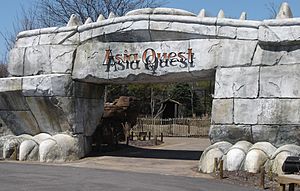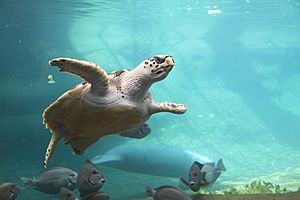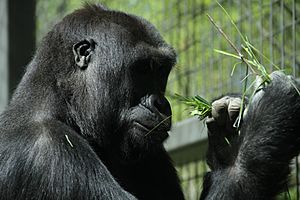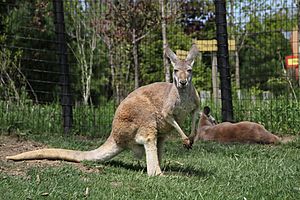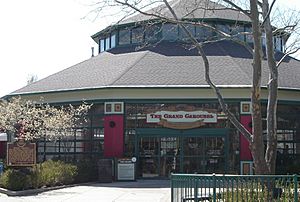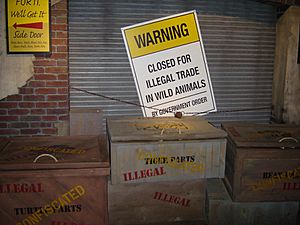Columbus Zoo and Aquarium facts for kids
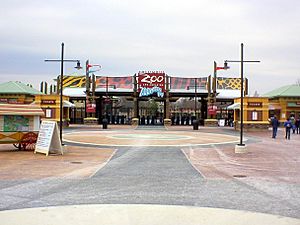
Zoo entrance
|
|
| Date opened | 1927 |
|---|---|
| Location | Powell, Ohio, United States |
| Land area | 234 ha (580 acres) |
| Coordinates | 40°09′23″N 83°07′06″W / 40.156266°N 83.118403°W |
| No. of animals | more than 7,000 |
| No. of species | over 800 |
| Memberships | AZA, WAZA |
| Major exhibits | North America, Heart of Africa, Asia Quest, Shores & Aquarium, Polar Frontier, Australia and the Islands, and Congo Expedition |
The Columbus Zoo and Aquarium is a famous non-profit zoo located near Powell, just north of Columbus, in Ohio, United States. It's known all over the world! In 2009, a travel guide even called it the best zoo in the United States. It was also ranked number one in 2012.
This amazing zoo is home to more than 7,000 animals. These animals represent over 800 different kinds of species. More than 2.3 million people visit the zoo every year. The animal exhibits are set up by different regions of the world. The zoo currently has eight of these special regions.
The Columbus Zoo also owns other fun places. These include an 18-hole golf course called Safari Golf Club. They also own Zoombezi Bay, which is a water park. Plus, there's Jungle Jack's Landing, a dry ride park. In total, the zoo owns a huge amount of land. A big part of this land is just for the zoo itself.
The zoo runs its own important conservation program. They give money to other programs that help animals. They also work on their own projects to protect wildlife. In the last five years, the zoo has given over $3.3 million. This money went to more than 70 projects in 30 different countries. The zoo also works closely with the Wilds. This is a large animal conservation center in southeast Ohio.
Contents
Exploring the Zoo's Regions
The Columbus Zoo is split into different areas. Each area features animals from a specific part of the world. These regions are designed to look and feel like their real-world locations. Newer regions have more detailed themes than older ones. You'll find food and souvenir shops throughout the zoo. Each shop also matches the theme of its region.
Besides walking, there are fun ways to get around the zoo. You can ride a train that goes around the North America region. There's also a tram that takes visitors to the Polar Frontier. You can even take a boat ride around the Islands of Southeast Asia region.
North America: Home Grown Fun!
The North America region is the second-largest and the oldest part of the Columbus Zoo. It has 15 big exhibits to explore. You'll see a wetlands area and a huge bird aviary. This aviary is home to over 40 different kinds of songbirds. The train ride circles this region. It passes by open plains exhibits where animals roam.
Animals you might see here:
- Black-tailed prairie dog (Cynomys ludovicianus)
- American beaver (Castor canadensis)
- Mexican wolf (Canis lupus baileyi)
- American black bear (Ursus americanus)
- Wolverine (Gulo gulo)
- North American river otter (Lontra canadensis)
- Bobcat (Lynx rufus)
- Cougar (Puma concolor)
- Moose (Alces americanus gigas & A. a. americana)
- Pronghorn (Antilocapra americana americana)
- American bison (Bison bison bison)
- Trumpeter swan (Cygnus buccinator)
- Bald eagle (Haliaeetus leucocephalus)
- Reindeer (Rangifer tarandus)
Polar Frontier: Chilly Adventures!
Polar Frontier opened in May 2010. It's one of the newest parts of the zoo. This area is an extension of the North America region. It features animals that live in cold places. You can see Arctic foxes and brown bears here. This region also brought polar bears back to the zoo. Their habitat has a huge pool. You can even watch them swim underwater! There's also a building for learning about conservation. A fun play area is also part of this exhibit. The zoo added a third polar bear in 2013. They also expanded Polar Frontier in 2014.
Animals you might see here:
- Arctic fox (Alopex lagopus)
- Brown bear (Ursus arctos)
- Polar bear (Ursus maritimus)
Asia Quest: Journey to the East!
Asia Quest opened in two stages in 2006. This region tries to make visitors feel like they are really in Asia. The exhibits are large and beautiful. They also blend in with the scenery. When you enter, you'll pass a waterfall. Then you go through a cave with indoor habitats. After that, you walk into a Chinese forest. Finally, you enter a pheasant aviary. It looks like an old Asian garden. Instead of fences, animals are kept separate by rock walls or glass. Asia Quest also encourages donations. These donations help protect animals that are endangered in the wild.
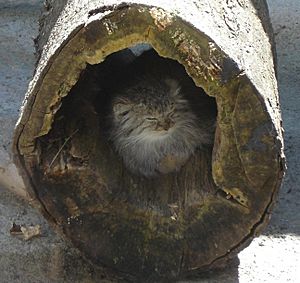
Animals you might see here:
- Reeves's muntjac (Muntiacus reevesi)
- Tufted deer (Elaphodus cephalophus cephalophus)
- Siberian musk deer (Moschus moschiferus)
- White-naped crane (Grus vipio)
- Red-crowned crane (Grus japonensis)
- Silvery lutung (Trachypithecus cristatus)
- Water monitor (Varanus salvator)
- Reticulated python (Python reticulatus)
- Little golden-mantled flying fox (Pteropus pumilus)
- Large flying fox (Pteropus vampyrus)
- Malayan sun bear (Helarctos malayanus)
- Red panda (Ailurus fulgens)
- Golden pheasant (Chrysolophus pictus)
- Swinhoe's pheasant (Lophura swinhoii)
- Reeve's pheasant (Syrmaticus reevesii)
- Markhor (Capra falconeri)
- Pallas's cat (Otocolobus manul)
- Amur tiger (Panthera tigris altaica)
- Amur leopard (Panthera pardus orientalis)
Shores and Aquarium: Under the Sea and More!
The Shores region is famous for its fish and manatee aquariums. These are called "Discovery Reef" and "Manatee Coast." Besides the indoor aquariums, you can also see American flamingos, American alligators, and Humboldt penguins.
Discovery Reef is a huge saltwater aquarium. It holds many kinds of fish, stingrays, sharks, and sea turtles. It also has a live coral exhibit. This is one of the largest in the United States.
Manatee Coast opened in 1999. It's a very special part of this region. It helps West Indian manatees, which are endangered. Their indoor habitat is enormous. This habitat is one of only two outside of Florida that cares for manatees. This makes it a very popular exhibit. The building has a roof that can open. This creates an outdoor space for the manatees in warm weather.
The Reptile Habitat is a building with many snakes, terrapins, and tortoises. The Columbus Zoo has helped breed many endangered reptile species. These include Jamaican boas and Roti Island snake-necked turtles.
Animals you might see here:
- West Indian manatee (Trichechus manatus)
- Hawksbill sea turtle (Eretmochelys imbricata)
- Humboldt penguin (Spheniscus humboldti)
- Caribbean flamingo (Phoenicopterus ruber ruber)
- Roti Island snake-necked turtle (Chelodina mccordi)
- Yellow-spotted river turtle (Podocnemis unifilis)
- Pancake tortoise (Malacochersus tornieri)
- Madagascar ground boa (Boa madagascariensis)
- Jamaican boa (Epicrates subflavus)
- Burmese python (Python molurus bivittatus)
- Pine snake (Pituophis melanoleucus)
- Plains garter snake (Thamnophis radix)
- King cobra (Ophiophagus hannah)
- Timber rattlesnake (Crotalus horridus)
- Solomon Islands skink (Corucia zebrata)
- Gila monster (Heloderma suspectus)
- American alligator (Alligator mississippiensis)
- Panamanian golden frog (Atelopus zeteki)
- Blue poison dart frog (Dendrobates tinctorius "azureus")
- Bonnethead shark (Sphyrna tiburo)
- Cownose ray (Rhinoptera bonasus)
- Clownfish (Genus Amphiprion)
- Zebra shark (Stegostoma fasciatum)
Congo Expedition: Into the African Rainforest!
The "Congo Expedition" opened in 2000. This area shows animals from the Central African rainforest. You'll find many primates, hooved mammals, and large cats here. There are also many birds in an aviary. A special part of this region is the primate area. It features three generations of Western lowland gorillas. These gorillas are descendants of Colo, a very famous gorilla.
The Columbus Zoo has a growing group of bonobos. Bonobos are also called pygmy chimpanzees. They are the closest living relatives to humans. Bonobos are only found in a few zoos outside their home in the Democratic Republic of the Congo. They are also a critically endangered animal.
Animals you might see here:
- Mantled guereza (Colubus guereza)
- African grey parrot (Psittacus erithacus)
- African leopard (Panthera pardus)
- Western lowland gorilla (Gorilla gorilla)
- Red river hog (Potamochoerus porcus)
- Bonobo (Pan paniscus)
- Mandrill (Mandrillus sphinx)
- Okapi (Okapia johnstoni)
- Black duiker (Cephalophus niger)
Voyage to Australia and the Islands: Down Under and Beyond!
The Australia region is on the far west side of the zoo. It sits along the Scioto River. The "Roadhouse" exhibit opened in 2003. The kangaroo walkabout, koala habitat, and Lorikeet Aviary opened in 2004. "Bob and Evelyn's Roadhouse" is an indoor exhibit. It shows animals from Southeast Asia, Australia, and New Zealand. You can see woylies and brown kiwis here. The "Roadhouse" also has an indoor aviary. It displays over twenty kinds of Asian and Australian birds. There's also an exhibit for an Indian crested porcupine and Prevost's squirrels.
The main attraction here is the Kangaroo Walkabout exhibit. You can walk right through the habitat with red kangaroos and eastern grey kangaroos! The Columbus Zoo is one of only a few US zoos to have koalas. They have both indoor and outdoor habitats for them. You can also see a short-beaked echidna indoors. The Lorikeet Garden is another fun exhibit. You can buy nectar and feed the rainbow lorikeets!
Featured Roadhouse animals include:
- Woylie (Bettongia penicillata)
- Prevost's squirrel (Callosciurus prevostii)
- North Island brown kiwi (Apteryx mantelli)
- Fishing cat (Prionailurus viverrinus)
- Matschie's tree-kangaroo (Dendrolagus matschiei)
- Feathertail glider (Acrobates pygmaeus)
- Lesser short-nosed fruit bat (Cynopterus brachyotis)
- Indian crested porcupine (Hystrix indica)
- Southern hairy-nosed wombat (Lasiorhinus latifrons)
Other animals you might see here:
- Short-beaked echidna (Tachyglossus aculeata)
- Woylie (Bettongia penicillata)
- Koala (Phascolarctos cinereus)
- Eastern grey kangaroo (Macropus giganteus)
- Red kangaroo (Macropus rufus)
- Rainbow lorikeet (Trichoglossus moluccanus)
The Islands of Southeast Asia region opened in 2003. Like Asia Quest, this area makes you feel like you're walking through a real forest. It uses man-made scenery and plants. There's also a waterway that flows around the region. You can take a boat ride on it to see the exhibits.
Animals you might see here:
- Lar gibbon (Hylobates lar)
- Siamang (Symphalangus syndactylus)
- Sumatran orangutan (Pongo abelii)
- Oriental small-clawed otter (Aonyx cinerea)
- Black swan (Cygnus atratus)
- Galah (Eolophus roseicapilla)
- Sulphur-crested cockatoo (Cacatua galerita)
- Komodo dragon (Varanus komodoensis)
Heart of Africa: The African Plains!
The "Heart of Africa" region is in the northern and eastern parts of the zoo. This large area features many animals from the African plains. You'll see lions, giraffes, cheetahs, zebras, and vervet monkeys. This area is designed to make you feel like you're on the African savanna. You can even feed giraffes and ride camels! There are also places to eat.
Animals you might see here:
- Dromedary camel (Camelus dromedarius)
- African lion (Panthera leo)
- Cheetah (Acinonyx jubatus)
- Vervet monkey (Cercopithecus aethiops)
- Masai giraffe (Giraffa camelopardis tippelskirchi)
- Reticulated giraffe (Giraffa camelopardalis reticulata)
- Grant's zebra (Equus quagga boehmi)
- Dama gazelle (Nanger dama)
- Thomson's gazelle (Eudorcas thomsonii)
- Slender-horned gazelle (Gazella leptoceros)
- Greater kudu (Tragerlaphus strepsiceros)
- Ostrich (Struthio camelus)
- Grey crowned crane (Balearica regulorum)
- Saddle-billed stork (Ephippiorhynchus senegalensis)
- Guineafowl (Family Numididae)
- Warthog (Phacochoerus africanus)
- Wildebeest (Connochaetes taurinus)
Other Fun Attractions
Mangels-Illions Carousel: A Ride Through History!
In the spring of 2000, the zoo added a special ride. It's a restored 1914 Mangels-Illions carousel. This carousel used to be at another park called Wyandot Lake. It was moved to the zoo after a big restoration project. This amazing carousel has 52 hand-carved horses. It also has two chariots and a Wurlitzer band organ. It's a very rare "grand carousel" in the Coney Island style. It was ridden 42,000 times in its first month at the zoo! By July 28, 2004, it had its one millionth rider.
Zoombezi Bay: Splash into Fun!
The zoo bought Wyandot Lake at the end of 2006. They turned it into "Zoombezi Bay". This new water park has 17 big slides and attractions. The park opened in May 2008. It's right next to Jungle Jack's Landing, the dry ride park.
Jungle Jack's Landing: Thrills and Rides!
When the zoo bought Wyandot Lake, they divided it into two parts. The new dry park is called Jungle Jack's Landing. It has 16 rides and attractions. This includes the famous Sea Dragon roller coaster.
Helping Animals: Conservation Efforts
The Columbus Zoo and Aquarium has a special conservation program. This program gives money to many projects outside the zoo. In 2010, the zoo gave over $2 million to help conservation projects worldwide. This money comes from fundraisers, visitor donations, and private funds. The zoo supports groups like the Dian Fossey Gorilla Fund and the International Elephant Foundation. They also help the Ohio Wildlife Center.
The zoo wants to help people learn more about conservation. They also want to raise more money for it. So, they've added information about threatened and endangered species to their exhibits. They also have donation boxes. These boxes help fund the many projects the Columbus Zoo supports.
The Columbus Zoo is also involved in conservation right at the zoo. Manatee Coast is not just an exhibit. It's also a rehabilitation center for injured manatees. Manatees are endangered in the wild. So, Manatee Coast teaches visitors about their situation. There's a whole room dedicated to manatee conservation. It has a video about their natural home and how to protect them.
The Columbus Zoo also has a breeding program for Mexican wolves. The goal is to have at least 100 wolves living in their natural areas again. Mexican wolves became extinct in the wild in the mid-1900s. This was because they were trapped, poisoned, and shot. Since the zoo started helping in 1992, 29 wolf pups have been born there.
Images for kids


